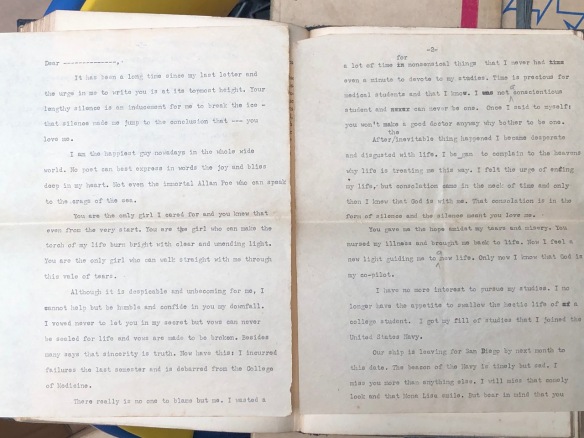
Penman for Monday, October 28, 2019
AT A dinner last week with friends in Ann Arbor, Michigan—an old haunt of mine, having done my master’s there more than thirty years ago—the talk came around to finding and retrieving valuable Filipiniana from the United States and wherever these precious objects—books, paintings, and other artifacts—may have been buried for the past century. I shared the story of how the oldest book in my small antiquarian collection—a book of English essays from 1551, published in London—turned up in Cubao, Quezon City, after having been gifted to its Pinoy owner who was a caregiver in Paris.
That discussion, in turn, reminded me of another interesting message I’d received a month earlier from a reader named Wassily Clavecillas, with whom I’d been exchanging notes about our shared interests (he also supplied me with information about the long-forgotten painter Anselmo Espiritu, whom I wrote about last July). With his permission, I’ll share a slightly edited version of Wassily’s message, which illustrates how literary and historical jewels can still emerge from the shadows:
“Professor, let me tell you about a book entitled Ataque de Li-Ma-Hong a Manila en 1574 by the Spanish writer Juan Caro y Mora, printed in 1898 in Manila. The item was the only Filipiniana object in the lot of Orientalia bequeathed to my aunt by her then employer/patron, who came from an affluent family in California.

“Encompassing roughly 155 pages, the book is interspersed with artfully crafted vignettes, landscapes, and battle scenery depicting the invasion of Manila by the infamous Chinese pirate Li Ma Hong—an event whose 445th anniversary will fall this November 29. The illustrator was none other than Vicente Mir Rivera, the Filipino Gilded Age artist, a contemporary of Juan Luna, Felix Resurreccion Hidalgo, Lorenzo Guerrero, and the brothers Manuel and Anselmo Espiritu. Though not as celebrated as Luna or Hidalgo, Rivera was an important artist and artisan, who also designed with lavish attention to detail the canonical crowns of the Nuestra Senora del Santisimo Rosario, which was executed by the jewelers La Estrella del Norte.
“The illustrations were rendered mostly in watercolor and presumably perished in the fires of war-ravaged Manila in WWII. What we have left, though not originals, are no less beautiful in their form, abounding in visions of verdant Filipino landscapes and seascapes, complemented with renderings of intrepid Spanish soldiers, fierce Chinese corsairs, and valiant Filipino warriors.
“The book was effectively a historical record of Spain’s erstwhile military and martial glories. This is the second edition of Juan Caro y Mora’s tome; a much rarer first edition was never sold but was given to subscribers of the author’s newspaper La Voz Española, which Mora edited.”
Wassily goes on further to say that the book was included in a lot of various Oriental antiques and ephemeras, mostly Japanese netsuke, fine silk scroll paintings, Qing dynasty jade and porcelain figurines, and numerous 19th-century travel books on Asia, which once adorned the richly decorated anterooms of a sprawling California estate.
Bequeathed to his aunt by her employer, for sentimental reasons she never sold this bounty and had the items packed and concealed away in her other home in another state in the US, where the collection remained safe, dormant but not forgotten. Some time ago she decided to go through all the contents again it was then that she found the book.

“Upon further scrutiny,” Wasily reports further, “I was excited to realize that Juan Caro y Mora had inscribed and dedicated the book to his Excellency Governor-General Fermin Jaudenes, the third-to-the-last Spanish-appointed Governor-General of the Philippines. Jaudenes was known for his role in the infamous ‘Mock Battle of Manila,’ where the collapsing Spanish forces orchestrated with the American occupiers the surrender of the City of Manila, to salvage the reputation of Imperial Spain and deny the Filipinos their hard-fought victory.
“One can only speculate if the book was given by the author as a morale booster to the embattled Governor General during what many consider as the death knell of Spain’s empire. The surrender of Manila it heralded the end of 300 years of European rule over the archipelago and marked the beginning of 50 years of Pax Americana.”
Many thanks, Wassily, for your account and perceptive commentary. I’ve never seen or even known about this book myself, of course, but it reinforces my conviction that many more treasures remain hidden out there, in some American or European attic or garage.
Over the past year, I’ve built up a small trove myself of old Filipiniana awaiting repatriation at my daughter’s place in California—multiple copies each of such popular staples as Harper’s History of the War in the Philippines, Atlas de Filipinas, and Our Islands and Their People, as well as another first edition of Stevan Javellana’s Without Seeing the Dawn. They may not be quite as exotic as Limahong’s story, or have such a splendorous provenance, but I hope to bring them home soon to spark wonder and delight in more Filipino eyes.

